#pemon
Explore tagged Tumblr posts
Note
pema/amon for the bad sex meme

4 notes
·
View notes
Text

when life gives you pemons you draw your favorite character as a furry
#danganronpa#danganposting#kokichi ouma#drv3 kokichi#danganronpa kokichi#kokichi fanart#danganronpa fanart#furry#furry art
13 notes
·
View notes
Note
LOVE Aqua's desgin. She reminds me of the enuma elish somewhat, with how the first two gods were embodiments of water in it, and how they did not like the noise of other life at first. She is so pretty the way water almost envelops her? I can just imagine it shimmering and ohhh I adore it. And her hairstyle makes me think of pearlstrings
Thank you so much!!
That is very interesting, I mostly took inspiration from Pemon's origin mythology to create her, but I am happy to see the lore and myth of creation I did is sound.
For her design, there are these round stones in the lake of Gran Sabana created from the water erosion that makes them perfectly round. The Pemón call them the grandparents of the fish. When they are taken out of the water, they usually tell you to put the stone back in the water so the stone can still try to reach their water family.
Here are some rough initial designs I did for her!

My idea was to give her an elemental veil to give her that sense of elegance but she can also move it at will (Vaporize it when she doesn't need it or turn it into ice if she needs a shield)
#dragon quest rise of the goddess#ask#im so happy when people comment on my design choices for my OCs it makes me go aaaaaaa
13 notes
·
View notes
Text

INTRO!!
hai!! my name is pemon/marker and i recently just installed tumblr! i hope i make LOTS of friends here!

ABOUT ME!
• my parents were born in the gambia, but i was born in the uk!
● im muslim!
● i'm multifandom! (mostly precure, DW, MWDH, and CRK tho...)
• i REALLY like magical girls, especially pretty cure!
● i'm the n1 cure whip fan!
● i also like dandy's world, especially brightney!!
• i'm on the autistic spectrum!
● milk chocolate and lasanga are my favourite foods! (especially my mum's lasagna...i luv my mum......)

DNI LIST...
• basic DNI list
• proshippers/darkshippers...why?
● ableists...stay 5 planets away from me
• islamoph0bes...PU stinky...

THAT'S ALL, FOLKS!
well, that was my intro! see yall at the next post!!
9 notes
·
View notes
Text
Sobre Salvajes
Los pemones de la Gran Sabana llaman al rocío Chiriké-yeetakuú, que significa Saliva de las Estrellas; a las lágrimas Enú-parupué, que quiere decir Guarapo de los Ojos, y al corazón Yewán-enapué: Semilla del Vientre. Los waraos del delta del Orinoco dicen Mejo-koji (El Sol del Pecho) para nombrar al alma. Para decir amigo dicen Ma-jokaraisa: Mi Otro Corazón. Y para decir olvidar dicen Emonikitane, que quiere decir Perdonar. Los muy tontos no saben lo que dicen. Para decir tierra dicen madre Para decir madre dicen ternura Para decir ternura dicen entrega Tienen tal confusión de sentimientos que con toda razón las buenas gentes que somos les llamamos salvajes.
Gustavo Pereira
19 notes
·
View notes
Note
YOU HAVE A PLANT (I think) NAMED LEOPOLD? What is it?
The actual plant name I mean
And hope the weather’s doing okay over there now! Stay safe :]
Leopold is a Meyers pemon tree and hes only ~3 years old!!! << rough estimate given hes only just blooming and stuff, we got him from. Home depot!!!!
Weathers calmed down since this afternoon and they're saying the storms are done for the week! Leopolds been moved outside once the wind calmed down!

3 notes
·
View notes
Text
Thanks for the rectification! However the original question is still left open. "What was the name for the electric eel before we knew about electricity?" If we only care about the names Europeans used for these animals it would be "numb-eel" because it would give you numbness in the parts of your body that are shocked. If we want to hear the perspective of the people who have known these animals for the longest i.e. the Indigenous people that lived alongside electric eels they are called puraké ('the one that numbs' in Tupi)(Wikipedia)/Poraqûe ("what to put to sleep" in Tupi) (Project Poraqûe), Arimma (wasn't able to find a translation, was only attributed to the "the Indigenous people of Venezuela" by this the Atlantic article but in Venezuela live the Wayuu, Warao, Ya̧nomamö, Kali'na, Pemon, Añu, Huottüja, Motilone Barí, Ye'kuana, and Yaruro. Spread among all these groups are three different families of languages so I don't know where to begin the the hunt for the meaning behind this name). So I see somewhat of a trend to call these knifefish by their ability to numb your body with the shocks of electricity.
So here is the answer to the original.question and my two cents learning from this whole thread was: Do a double check and do at least 2 minutes of research before you just trust shit on the internet. (If anyone is interested I just put "indigenous name electric eel" into the search bar and got all of that from it)
Have you seen this post?

You probably have. It currently has over 120,000 notes, largely because of this addition.
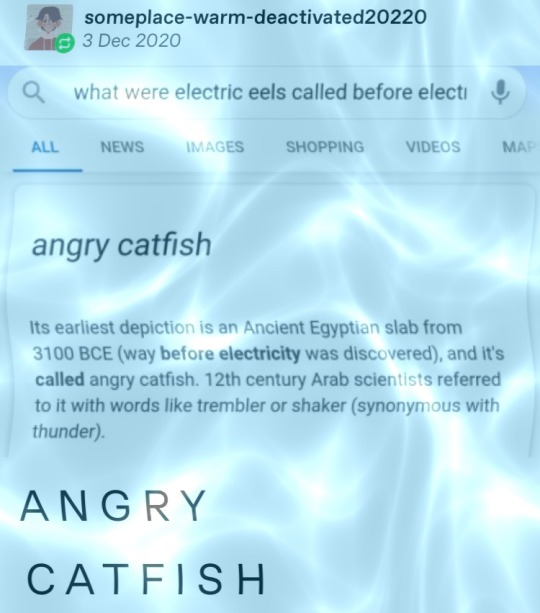
Of course it's going to get reblogged, this kind of unsourced factoid does numbers on here. But something about it wasn't quite right.
A bit of searching turned up the origin of the "fact".


Alright, so it's someone who posted this on reddit 4 years ago and somehow ended up in the search hits. And the post confuses the electric eel (from South America) with the electric catfish (from the Nile, which the Egyptians would have known about).
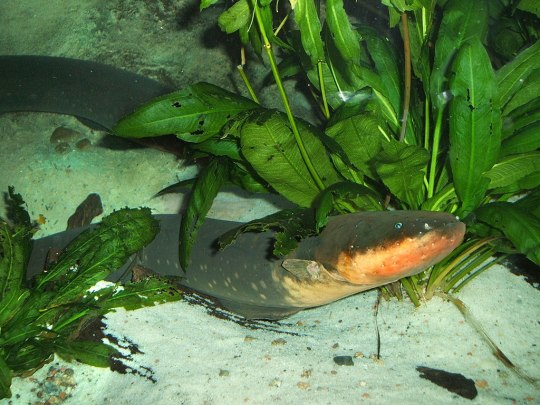
Reminder: this is an electric eel (Electrophorus electricus). It is from South America. (image from Wikipedia)
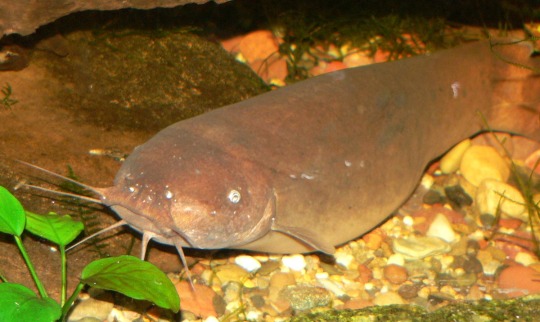
And this is an electric catfish (Malapterurus electricus). It is from the Nile and would have been familiar to the ancient Egyptians. (image from Wikipedia)
And then of course people were speculating in the notes to that post about trade routes between South America and Egypt. Excellent scholarship everyone.
At this point I was ready to call it another made-up internet fact that gets reified by people repeating it. But something was still bothering me.
An ancient Egyptian slab from 3100 BC. What could that be...
Oh.
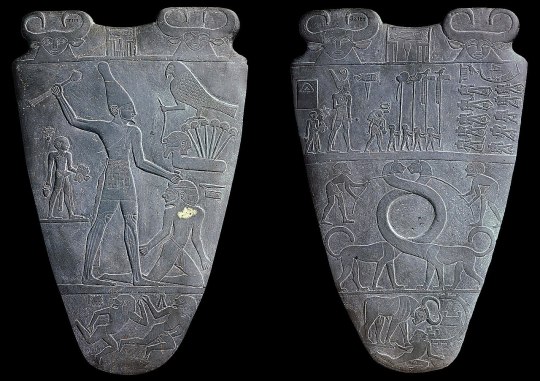
The Narmer palette. It's the goddamn Narmer palette. (image, once again, from Wikipedia)
So where is this "angry catfish"?
It's not the Egyptian name for the electric catfish.
It's... Narmer. It's Narmer himself.

Narmer's name is written as above (detail of top middle of the palette), using the catfish (n`r) and the chisel (mr), giving N'r-mr. The chisel is associated with pain, so this reads as "painful catfish", "striking catfish", or, yes, "angry catfish" or other similar variants, although some authors have suggested that it means "Beloved of [the catfish god] Nar".
So.
Where does this leave us?
It would appear that this redditor not only confused electric eels with electric catfish, but also confused a Pharaoh's name with the name of a fish. And then it got pushed to the top search hits by a crappy search engine and shared uncritically on tumblr.
In short, "the electric eel is called angry catfish" factoid actually literacy error. Angry Catfish, who ruled upper Egypt and smote his enemies, is an outlier adn should not have been counted.
Also the Arabic name for the electric catfish is raad (thunder) or raada (thunderer).
References
Afsaruddin, A., & Zahniser, A. H. M. (1997). Humanism, culture, and language in the Near East: studies in honor of Georg Krotkoff. Eisenbrauns.
Clayton, P. A. (2001). Chronicle of the Pharaohs. Thames & Hudson.
Godron, G. (1949). A propos du nom royal. Annales du Service des antiquités de l'Egypte, 49, 217-221.
Sperveslage, G., & Heagy, T. C. (2023). A tail's tale: Narmer, the catfish, and bovine symbolism. The Journal of Egyptian Archaeology, 109(1), 3-319.
45K notes
·
View notes
Note
linky pemon
nyverw.. we meat again
6 notes
·
View notes
Text

Image Source > Link Stars are seen in the night sky over Kukenan (L) and Roraima mounts near the Tec Camp, near Venezuela's border with Brazil January 14, 2015. A mysterious table-topped mountain on the Venezuela-Brazil border that perplexed 19th century explorers and inspired "The Lost World" novel is attracting ever more modern-day adventurers. Once impenetrable to all but the local Pemon indigenous people, now several thousand trekkers a year make the six-day hike across Venezuela's savannah, through rivers, and up a narrow path that scales Mount Roraima's 600-meter cliff-faces. While that is a help to Venezuela's tottering tourism industry and brings revenues to local communities, it is also scattering a prehistoric landscape with unwanted litter. Picture taken using a slow exposure.
Taken by - Carlos Garcia Rawlins
2015-02-03T100818Z_1326988505_LM2EB220X5M01_RTRMADP_3_VENEZUELA-RORAIMA-WIDERIMAGE
0 notes
Photo
Monte Roraima, also known as a tepui, is located at the tri-junction of Venezuela, Brazil, and Guyana, predominantly within Venezuela's Canaima National Park. Rising approximately 2,810 meters (9,219 feet) above sea level, its sheer cliffs soar up to 400 meters (1,300 feet) high. The flat summit, often veiled in clouds, spans about 31 square kilometers (12 square miles), featuring unique rock formations, deep crevices, and a distinct ecosystem with rare flora, including carnivorous plants.
Monte Roraima is one of the oldest geological formations on Earth, dating back around 2 billion years. It holds cultural significance for the indigenous Pemon and Kapon peoples, who regard it as a sacred site. Besides its geological and cultural importance, Monte Roraima has inspired literature, including Arthur Conan Doyle's "The Lost World."

41K notes
·
View notes
Note
How do you feel about your evil twin Pemons and Die, PeDiemons even
Why, have they been talking shit about me again? The witch that separated us at birth said that could be a side effect of the curse.
1 note
·
View note
Text
León Magno Montiel @leonmagnom Los hombres de las ínsulas se levantan entre la sal, el sol, las arenas ardientes y el mar que reparte vida y muerte en un mismo compás. Para ellos el mar es un jardín sumergido, otras veces; un desierto verdoso. En ese entorno natural soberbio, los habitantes de las islas forman su carácter, en medio de esa biodiversidad llena de vida, de poesía, de peligros y asechanzas: se determina la índole de su sangre. Gustavo Pereira es un hombre de la isla, nació el 7 de marzo de 1940 en Paraguachoa, que significa "La isla de las perlas en voz guaquerí". En el sector Punta de Piedras exactamente. El primer hijo del matrimonio inusitado y novelesco que formaron Ofelia Salazar, bella margariteña, y el aventurero Benito Perera (sin la i, hasta ese momento. Luego adoptó el Pereira). Su padre quedó huérfano y lo protegió, lo levantó Monseñor Pellín, lo educó bajo su égida, su férrea tutela. Benito Perera en su adultez, recorrió las selvas venezolanas, fue un pionero de las redes ferroviarias en el país. Era de ascendencia italiana, conocía bien esa cultura. Ofelia era una mujer contemplativa, una buena lectora, una dama serena. La juventud de Gustavo estuvo siempre circunscrita al Oriente de Venezuela, entre Puerto La Cruz y los pueblos aledaños. Se formó en la Universidad Central de Venezuela en la carrera de Derecho en 1963, por esos años vivía entre oriente y la Caracas, la megalópolis cultural que lo sedujo; entonces comenzaba su militancia política con los movimientos de izquierda. En 1980 se marchó en París para realizar el Doctorado en Letras Hispánicas, trabajó sobre "Los Cronistas de las Indias", su lenguaje, durante dos intensos años permaneció en la cuidad luz. Su brillante tesis doctoral selló su maridaje con las culturas primigenias del continente americano. Él es un sabio de esa fuente: la cultura indoamericana. Pereira ha reflejado en su poesía la pasión india que lo envuelve, es un descubridor de los misterios de los pueblos originarios, desde México a la Patagonia sigue indagando sus riquezas artísticas, su mundo agreste y originario. Cuando tenía 12 años de edad, tuvo un tránsito relampagueante por la ciudad de Maracaibo, allí estudió en el año 1952, conoció la ciudad puerto, ensenada de poetas, la madre de la gaita, la urbe amante del lago. En 1953 regresó a su Puerto La Cruz, a los 16 años publicó su primer plaquete de poemas. Desde entonces no ha cesado de publicar, tiene una veintena de títulos de su autoría: poemarios, ensayos, antologías de su obra, artículos arbitrados, varios tomos han sido traducidos. En 1967 se casa con Maureen Pacheco y tienen tres hijos, que son fuentes de su creación literaria más personal. En 1992 Gustavo Pereira publicó su poema irónico y reivindicativo, "Sobre Salvajes" que tuvo una gran repercusión en el mundo literario e intelectual: "Los pemones de La Gran Sabana llaman al rocío chiriké yeetakuú, que significa saliva de las estrellas. A las lágrimas enú parupué, que quiere decir guarapo de los ojos. Y al corazón yemán enapue: semilla del vientre. Los waraos del Delta del Orinoco dicen mejokoji (el sol del pecho) para nombrar el alma.Y para decir olvidar dicen emonikitane, que quiere decir perdonar. Los muy tontos no saben lo que dicen; para decir tierra dicen madre para decir madre dicen ternura para decir ternura dicen entrega. Tiene tal confusión de sentimientos que con toda razón las buenas gentes que somos los llamamos salvajes." El poeta Gustavo Pereira Salazar es un hombre poseedor de una colosal cultura, un sabio del lenguaje, maestro de la historia y las tradiciones venezolanas. Eso propició que fuese elegido para redactar el preámbulo de la Constitución de la República Bolivariana de Venezuela en 1998, logrando un texto admirable. En ese momento fungía como parlamentario. Por esos días, él había definido la cultura como el eje de salvación de cualquier país, junto a la justicia y la libertad; son las tres banderas indivisibles que debemos llevar en ristre:
"Donde existe cultura no hay miseria, en un barrio o en una urbanización cuyos habitantes han tenido acceso a la cultura puede encontrarse pobreza, pero no miseria. Porque la cultura es una salida a la miseria. No hay un proceso de transformación política si no hay un proceso de transformación cultural." Como ser insular, individuo meditabundo de los misterios del mar, Gustavo plasma en su poesía la belleza y la fuerza de las mareas, el llanto de los naufragios, las arenas retorcidas por la resaca, la lenta agonía de las embarcaciones corroídas por el salitre. Así cantó en su poema "Pisada", de 1981: "La hallé esta mañana en la arena, ni la alta marea ni los vientos pudieron llevársela. Brilla como una moneda nueva en medio de la playa húmeda". Luego de leer el grueso de su obra y de conocer el universo pereriano, concluyo que este poeta margariteño es un bastión del amor a nuestro país, es una voz que le ha cantado a sus raíces y goza de absoluta vigencia. Logró una clara valoración del colectivo hispano, de sus connacionales, quienes lo escuchan o lo leen con pasión. Sus somaris son intuiciones poéticas de relampagueante belleza, los vemos en agendas, mensajes digitales, recitados en la radio, en epígrafes, son parte del quehacer venezolano. Los somaris son poemas breves que se inspiran en los haikus japoneses, en los epigramas griegos; pero son una creación de Gustavo Pereira, que seguirán apareciendo hasta en grafitis. Tiene la frescura, la espontaneidad y síntesis que este tiempo exige, acordes con la actual sociedad de la información: "Me sé perdido en ti Me se envuelto en tu madeja no puedo saber cómo zafarme de tu abrazo ¿Cómo diablo zafarme de tu abrazo? Esta desconocida sustancia de desdichas me lleva hasta tu vientre y desde allí puedo ver cómo la mañana penetra en ti. Tu risa es para mi la puerta abierta del tiempo que vendrá, y en tus abrazos soy muelle con barcos y sueños." Una faceta poco difundida en la vida del gran poeta Pereira es su vocación por el dibujo y la pintura, a ese quehacer de óleos y pinceles dedicó muchos días, muchas horas, y logró crear obras hermosas. Lo inspiró su admiración por los grandes pintores y su amor por el color: "Ando en pos de los azules y del rojo que es la pasión", afirmó. Es un devoto perdido de Marc Chagal, de Vicent Van Gogh y Max Ernest. Honores al poeta isleño, vivas para el escritor venezolano que celebró 80 años de edad entre cantos de coral y odas de la marejada. Hombre que cada día se hace más universal, más vital. El rapsoda oriental Gustavo Pereira: un hombre de mar, con su extraño corazón, como diría Stevenson. Para recibir en tu celular esta y otras informaciones, únete a nuestras redes sociales, síguenos en Instagram, Twitter y Facebook como @DiarioElPepazo El Pepazo
0 notes
Text
We propose the common name, Northern Green Anaconda, for Eunectes akayima sp. nov. Before the arrival of the Spaniards, northern Venezuela was occupied by various Indigenous nations, among which the Caribs were an important group. Several Carib nations remain including the Kariña, Panare, Yekuana, Pemones, and Akawaio. The word for anaconda in various Cariban languages is a variant of akayima/okoyimo/okoimo, in which akayi/okoyi/okoi means “snake” and the suffix -ima/-imo means “large”. The suffix -ima/-imo does not necessarily mean ‘large’ in a physical sense. Rather, it is used to denote the kind of largeness that indicates a different category of being. The literal translation of akayima is “The Great Snake” (S. Gildea pers. Communication). [...] We, therefore, acknowledge the culture of these Indigenous people who share their territories with this species by adopting their word for anaconda as the specific epithet for this new species. We propose the common name for E. murinus as Southern Green Anaconda, to promote taxonomic stability for the most widely distributed species and avoid confusion.
-Disentangling the Anacondas: Revealing a New Green Species and Rethinking Yellows by Jesús Rivas; Paola De La Quintana; Marco Mancuso; Luis Pacheco; Gilson Rivas; Sandra Mariotto; David Salazar-Valenzuela; Marcelo Tepeña Baihua; Penti Baihua; Penti Burghardt; Freek Vonk; Emil Hernandez; Juán Elías García-Pérez; Bryan Fry; Sarah Corey-Rivas
hi do y'all mind if i misuse this blog entirely for a second. idk why i'm asking i don't actually care they found a new snake it's a New Snake we didn't know about this snake before!!!!
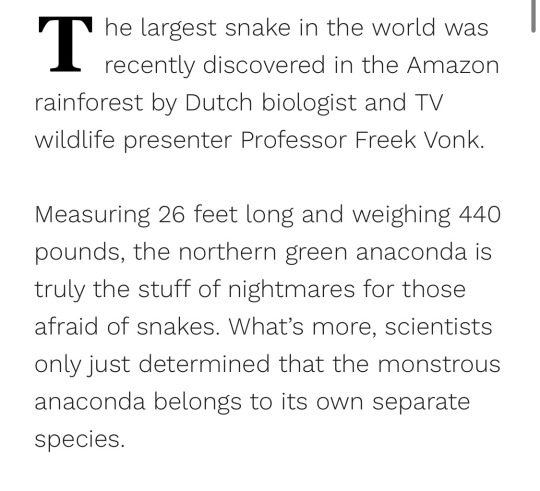
91K notes
·
View notes
Text
🌟 Angel Falls: The Mightiest Waterfall of The Earth 🌟
Nestled deep within the heart of the Venezuelan jungle lies a natural wonder that seems almost divine in its beauty and scale. Angel Falls, or "Salto Ángel" as it's known locally, is a breathtaking testament to the power of nature. In this article, we'll take you on a virtual journey to discover the majesty of the world's tallest waterfall and its awe-inspiring surroundings.
1. The Divine Descent 🌊 Angel Falls plunges an astounding 3,212 feet (979 meters) from the edge of Auyán-tepui, one of the many towering table mountains found in Venezuela's Canaima National Park. Imagine a column of water taller than the Eiffel Tower descending from the heavens, creating a mesmerizing spectacle.
2. Auyán-tepui: The Lost World 🏞️ Auyán-tepui, the plateau from which Angel Falls descends, is often referred to as "The Lost World." It's an apt name, as this otherworldly landscape seems like something out of a science fiction novel. Rugged cliffs, dense vegetation, and a sense of isolation make it a unique and mystical place.
3. The Discovery 🔍 Angel Falls was named after Jimmy Angel, an American aviator who crash-landed on Auyán-tepui in 1933 while searching for valuable ore deposits. His accidental discovery of the falls brought global attention to this natural wonder.
4. The Indigenous Pemon People 👣 The Pemon people, the indigenous inhabitants of the region, have revered Angel Falls for centuries. They call it "Kerepakupai Merú," which translates to "waterfall of the deepest place." For them, it holds deep spiritual significance.
5. Chasing Waterfalls: A Must-Visit Destination 🌄 Visiting Angel Falls is an adventure in itself. The journey involves a combination of hiking, riverboat rides, and navigating the challenging terrain of Canaima National Park. The effort is undoubtedly worth it for the chance to witness this natural masterpiece up close.
6. The Rainforest Oasis 🌿 Surrounding Angel Falls is a lush rainforest teeming with biodiversity. The park is a UNESCO World Heritage site, home to an incredible array of flora and fauna, including rare orchids and elusive jaguars.
7. When to Visit 🌤️ The best time to visit Angel Falls is during the wet season, typically from June to November. During this period, the falls are at their most magnificent, with water thundering down in all its glory.
8. Local Guides and Eco-Tourism 🌳 Exploring this pristine wilderness requires the expertise of local guides who understand the terrain and respect the delicate ecosystem. Eco-tourism initiatives in the region promote responsible travel that benefits both visitors and the environment.
9. A Natural Sound and Light Show 🌈 Rainbows often grace the base of Angel Falls, adding a magical touch to an already enchanting scene. The sight of sunlight refracting through the cascading mist is nothing short of spectacular.
10. A Cinematic Wonder 🎥 Angel Falls has captured the imagination of filmmakers worldwide. It served as the inspiration for Paradise Falls in Disney-Pixar's "Up" and has featured in numerous documentaries and adventure films.
Angel Falls is not merely a waterfall; it's a testament to the grandeur of nature and the spirit of exploration. If you're seeking a journey into the heart of the Venezuelan jungle to witness this marvel, you'll be rewarded with memories that will last a lifetime. Whether you're an adventurer, a nature enthusiast, or simply someone who appreciates the splendor of our planet, Angel Falls is a destination that should be on your bucket list. 🌎✨
#AngelFalls#Venezuela#NaturalWonder#AuyánTepui#WaterfallMagic#AdventureAwaits#EcoTourism#PemonPeople#LostWorld#RainforestOasis#TravelGoals#BucketList#NatureLovers#ExploreTheUnseen#DiscoverVenezuela#JungleAdventure#WondersOfTheWorld#MustVisit#IntoTheWild#WaterfallChasers#SpectacularScenery#RainbowMagic#UNESCOHeritage#MovieInspiration#EarthlyParadise
0 notes
Text
Anthromorphic Fantasy Universe OC's:
Greg Lambert (Delacroix)- werecat, green. Had an ex-bf named...i honestly can't recall. Anyways, I'll rename him for now uh...Pemon. Because...why not lmao.
Hector Lambert- Greg's half-brother
Anne Delacroix- Greg's human(?) mother
Vicky Lambert- Hector's mother
Benedict Lambert- Hector and Greg's biological father
Agustus- A merman who was saved by Greg, who later on became his loyal best friend.
(will update)
1 note
·
View note